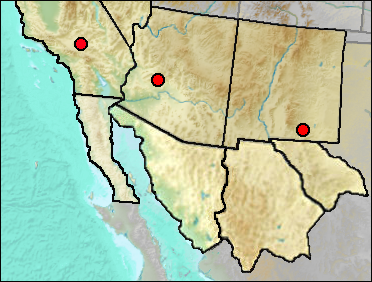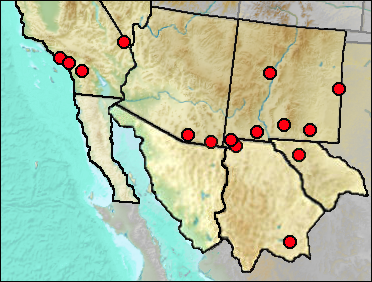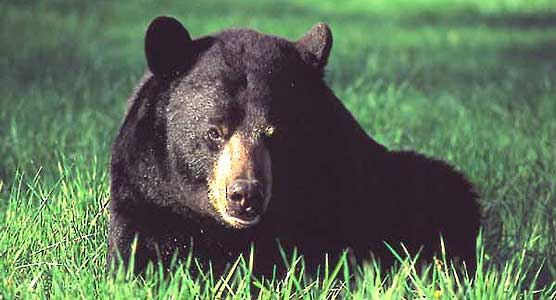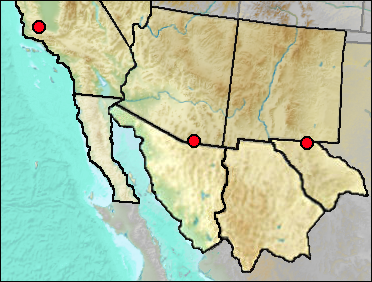Class Mammalia
Order Carnivora
Family Ursidae
Ursus sp.—Ursine Bears // Ursus americanus—Black Bear // Ursus arctos—Brown Bear
There are two bears of the genus Ursus in the Pleistocene fossil record of our region as well as historically in modern times. The Brown Bear (the Grizzly Bear of most Westerners) was widespread in western North America before being killed off from most of the region by humans; the smaller Black Bear is still widely distributed.
Discrimination of fossil remains is difficult. According to Kurtén and Anderson (1980), Black Bears during the Wisconsin in many cases were as large as modern U. arctos. There was marked reduction in size of Black Bears in the Holocene. Kurtén and Anderson use the size of M2 to separate the two species (maximum fossil M2 of U. americanus: 34 mm, with very few U. arctos having such a short M2). Unfortunately, most Ursus remains are of postcranial elements.
Literature.

Sites cited here are based largely on fragmented material tentatively identified as bear, but not sufficient for specific identification.
Sites.
Irvingtonian/Rancholabrean: Manix Lake (Jefferson 1991b: cf. gen.).
Rancholabrean: Red Creek (Mead et al. 2005).
Early/Early-Mid Wisconsin: Rm Vanishing Floor (Harris 1993c: cf.); Sabertooth Camel Maze (Harris 1993c: ?).
Mid/Late Wisconsin: Animal Fair (Harris 1993c: cf.).
Late Wisconsin/Holocene: Balcony Room (Harris 1993c: ?).
Literature.
Harris 1993c; Jefferson 1991b; Mead et al. 2005.

 As noted in the Ursus sp.
account, discrimination may be difficult. Most identifications are on the basis of size
and thus somewhat problematical.
As noted in the Ursus sp.
account, discrimination may be difficult. Most identifications are on the basis of size
and thus somewhat problematical.
Fig. 1. Black Bear. Photograph courtesy of U.S. National Park Service.
In our region, Black Bears tend to stick to forested montane areas, but not
exclusively. They have been reported, for example, from Fort Bliss in the vicinity of
El Paso.

Fig. 2. Fossil baculum of Ursus americanus from Isleta No. 1. Rodent gnawing can be seen at and near the proximal (left) end. Scale in mm.
Sites.
Mid Wisconsin: Papago Springs Cave (Skinner 1942); Pendejo Cave (Harris 2003); U-Bar Cave (Harris 1987: cf.).
Mid/Late Wisconsin: Diamond Valley (Springer et al. 2009); Rancho La Brea (Stock and Harris 1992).
Mid/Late Wisconsin/Holocene: Jimenez Cave (Messing 1986); Sierra Diablo Cave (UTEP).
Late Wisconsin: Antelope Cave (Reynolds, Reynolds, Bell, and Pitzer 1991); Blackwater Loc. No. 1 (Slaughter 1975); Human Corridor (Harris 1993c); La Mirada (Jefferson 1991b); Lehner Site (Saunders 1977); Park Place (Jefferson 2014); U-Bar Cave 13-14 ka (Harris 1989).
Late Wisconsin/Holocene: Aden Fumarole (Harris 1993c); Howell's Ridge Cave (Harris 1993c); Isleta Cave No. 1 (Harris 1993c); Isleta Cave No. 2 (Harris 1993c).
Literature.
Harris 1987, 1989, 1993c, 2003; Jefferson 1991b, 2014; Messing 1986; Reynolds, Reynolds, Bell, and Pitzer 1991; Saunders 1977; Skinner 1942; Slaughter 1975; Springer et al. 2009); Stock and Harris 1992).

Synonyms. Ursus horribilis.
 Brown Bears were relatively late comers to the region
south of the Wisconsin Ice Sheets. Kurtén and Anderson (1980) pointed out that
they had knowledge of only one site south of the ice sheets that includes both
Arctodus and U. arctos and suggested the two may have been in competition,
though they also noted that both species occurred over an extensive span of time in
Alaska north of the ice.
Brown Bears were relatively late comers to the region
south of the Wisconsin Ice Sheets. Kurtén and Anderson (1980) pointed out that
they had knowledge of only one site south of the ice sheets that includes both
Arctodus and U. arctos and suggested the two may have been in competition,
though they also noted that both species occurred over an extensive span of time in
Alaska north of the ice.
Fig. 1. Ursus arctos. Photograph by Tom Smith, courtesy of the U.S. Geological Survey.
Large numbers of "Grizzly Bears" have been named in North America. Hall (1981) lists 86 different types—species and subspecies, mostly species. Most have been eradicated and are represented by minimal materials in biological collections. Current interpretation is that all of the non-Ursus americanus ursine bears of North America, other than the Polar Bear, belong to one species, the Holarctic Ursus arctos.
Sites.
Rancholabrean: Huachuca Mountains Cave (Czaplewski and Willsey 2013: cf.).
Mid Wisconsin: McKittrick (Schultz 1937).
Late Wisconsin/Holocene: Williams Cave (Ayer 1936: cf.).
Literature.
Ayer 1936; Czaplewski and Willsey 2013; Hall 1981; Kurtén and Anderson 1980; Schultz 1937.
Last Update: 22 Apr 2015